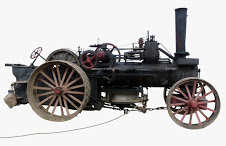Global Politics
THE INDUSTRIAL REVOLUTION BEGIN IN BRITAIN
In 17th century Britain, the beginnings of an agricultural revolution would eventually lead to an industrial revolution, changing the country – and the world – forever. But why Britain? There were several reasons

05 December 2017 | by Jess Sharman
According to ‘The Future of Jobs’ 2016 report by the World Economic Forum, we are in the midst of a fourth phase of industrial revolution, with technology rapidly developing in areas like 3D printing, robotics and artificial intelligence.
In this series, we explore the history of the industrial revolution so far and take a look at how what’s being developed now will change the way we work and live.
The industrial revolution begins in Britain
In 17th century Britain, the beginnings of an agricultural revolution would eventually lead to an industrial revolution, changing the country – and the world – forever. But why Britain? There were several reasons:
Agriculture
Agriculture had been Britain’s primary economy for centuries and the introduction of new farming systems in the 18th century resulted in better crops, more food, and healthier people. As a result, the population grew, and that meant a larger workforce.
Natural resources
Three natural resources played key roles in the industrial revolution: coal, iron and waterways. Britain had them all in abundance. Before steam was harnessed, water served as a primary source of power. Britain’s waterways also provided a mode of transportation for importing and exporting goods.
Coal was used to power steam engines, and advancements in steam engine technology meant that coal could be used more effectively. Large deposits of iron meant that it didn’t have to be imported, and that paved the way to several major innovations in iron-making technology.
Political stability
Civil war and revolution (1603–1714) greatly weakened monarchy control, thus changing the way that prices, wages and interest rates were determined. The ideas of John Locke, Adam Smith and the revolutionaries, which provided philosophical and economic grounds for the protection of individual rights, also had a strong influence on changing British culture and politics.
Meanwhile, our distance from mainland Europe protected us from wars that were happening abroad. The result of all of these factors was that the country was able to enjoy a long period of peace and prosperity in which workers were able to thrive and save money.
This increased population wealth, along with our rich natural resources and advancing agricultural production, brought about economic stability and increased investment in developing new technologies.
Freedom of thought
British scientists played a key role in the industrial revolution, and their inventions were made possible by the country’s rational and scientifically-focused attitude towards intellectual development.
Profit-driven agriculture
Before the war, much of the land in England was collectively ‘owned’ and the serf system meant there was little incentive to improve lands or produce more than was needed for immediate sustenance.
However, by 1830 most of it had made its way into the hands of individual owners. For the first time, farmers were able to own their own lands, improve and cultivate them as they saw fit, and reap the rewards for doing so.
The result was increased competition, which sparked innovative thinking and encouraged investment. Increased demand for better and more efficient agricultural tools led to a number of innovations, including the seed drill (1731) and threshing machine (1784).
Improvements to the land itself meant that the quality and quantity of crops were improved. It is estimated that in the period between 1700 and 1850, agricultural production increased by 172% whilst the number of people within the population required to produce at that level decreased from 55% to 22%.
With less labour needed for agricultural efforts, doors were opened to growth and innovation in other industries.
Better infrastructure
Using money saved as a result of more efficient agricultural production, farmers, private businessmen and entrepreneurs set their sights on improving Britain’s transportation system. Most of the roads, canals and railways built during this time were not financed by government but by individuals.
Interestingly, whereas English roads had been amongst the worst in Europe, this change in financier not only improved existing roads but allowed for the development of a vast network of new roads. As a result, production and trade volume increased and vendors were able to market their products nationally as well as locally.
Between 1760 and 1820, canals were the primary mode of transportation for heavy freight, providing links between major industrial areas and between major waterways. The first major railway opened in 1830, connecting Liverpool and Manchester and 20 years later, over six thousand miles of track had been laid.
Railways reduced both transport costs and travel times.
Powered by steam
Key to mass production and the increase in foreign trade was the ability to harness steam as a power source, and key to the steam engine was coal.
Improvements in mining technology meant that more coal could be extracted, which meant, in turn, that steam power became a viable, affordable power option for both industry and transportation.
By 1800 steam had become a reality in Britain. The country’s primary industries were vastly improved, making us leaders in raw resource production through mining, textile production, and metalwork manufacturing.
By 1820, the introduction of steam-powered trains and ships opened up even more doors, both within the country and internationally. By the time Victoria took the throne, Britain’s place as the world’s most powerful trading nation was well established.
Some of the key events surrounding the creating of the steam engine include:
In 1690, Frenchman Denis Papin used steam pressure to move a piston. While he struggled to find acceptance of his idea, his discovery served as the foundation for future advancements.
The Miner’s Friend was patented by Thomas Savery in 1698, becoming the first practical machine to be powered by steam. Using Papin’s design as its basis, the device was used to remove water from flooded mines. Although highly-problematic, the Miner’s Friend played an important part in determining how steam powered machinery would develop.
The first commercially successful steam engine was built in 1712 by Thomas Newcomen. As with the Miner’s Friend, its purpose was to pump water from mines.
However, by replacing the receiving vessel with a cylinder and piston, Newcomen’s design solved many of the problems associated with Savery’s machine, thus allowing miners to dig deeper and work uninterrupted by flooding. The result was a massive increase in coal production.





